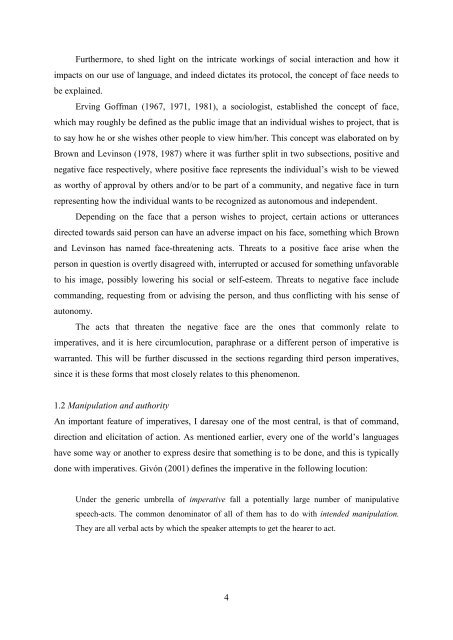The function of non-canonical imperatives in the languages of Europe
The function of non-canonical imperatives in the languages of Europe
The function of non-canonical imperatives in the languages of Europe
You also want an ePaper? Increase the reach of your titles
YUMPU automatically turns print PDFs into web optimized ePapers that Google loves.
Fur<strong>the</strong>rmore, to shed light on <strong>the</strong> <strong>in</strong>tricate work<strong>in</strong>gs <strong>of</strong> social <strong>in</strong>teraction and how it<br />
impacts on our use <strong>of</strong> language, and <strong>in</strong>deed dictates its protocol, <strong>the</strong> concept <strong>of</strong> face needs to<br />
be expla<strong>in</strong>ed.<br />
Erv<strong>in</strong>g G<strong>of</strong>fman (1967, 1971, 1981), a sociologist, established <strong>the</strong> concept <strong>of</strong> face,<br />
which may roughly be def<strong>in</strong>ed as <strong>the</strong> public image that an <strong>in</strong>dividual wishes to project, that is<br />
to say how he or she wishes o<strong>the</strong>r people to view him/her. This concept was elaborated on by<br />
Brown and Lev<strong>in</strong>son (1978, 1987) where it was fur<strong>the</strong>r split <strong>in</strong> two subsections, positive and<br />
negative face respectively, where positive face represents <strong>the</strong> <strong>in</strong>dividual’s wish to be viewed<br />
as worthy <strong>of</strong> approval by o<strong>the</strong>rs and/or to be part <strong>of</strong> a community, and negative face <strong>in</strong> turn<br />
represent<strong>in</strong>g how <strong>the</strong> <strong>in</strong>dividual wants to be recognized as autonomous and <strong>in</strong>dependent.<br />
Depend<strong>in</strong>g on <strong>the</strong> face that a person wishes to project, certa<strong>in</strong> actions or utterances<br />
directed towards said person can have an adverse impact on his face, someth<strong>in</strong>g which Brown<br />
and Lev<strong>in</strong>son has named face-threaten<strong>in</strong>g acts. Threats to a positive face arise when <strong>the</strong><br />
person <strong>in</strong> question is overtly disagreed with, <strong>in</strong>terrupted or accused for someth<strong>in</strong>g unfavorable<br />
to his image, possibly lower<strong>in</strong>g his social or self-esteem. Threats to negative face <strong>in</strong>clude<br />
command<strong>in</strong>g, request<strong>in</strong>g from or advis<strong>in</strong>g <strong>the</strong> person, and thus conflict<strong>in</strong>g with his sense <strong>of</strong><br />
autonomy.<br />
<strong>The</strong> acts that threaten <strong>the</strong> negative face are <strong>the</strong> ones that commonly relate to<br />
<strong>imperatives</strong>, and it is here circumlocution, paraphrase or a different person <strong>of</strong> imperative is<br />
warranted. This will be fur<strong>the</strong>r discussed <strong>in</strong> <strong>the</strong> sections regard<strong>in</strong>g third person <strong>imperatives</strong>,<br />
s<strong>in</strong>ce it is <strong>the</strong>se forms that most closely relates to this phenome<strong>non</strong>.<br />
1.2 Manipulation and authority<br />
An important feature <strong>of</strong> <strong>imperatives</strong>, I daresay one <strong>of</strong> <strong>the</strong> most central, is that <strong>of</strong> command,<br />
direction and elicitation <strong>of</strong> action. As mentioned earlier, every one <strong>of</strong> <strong>the</strong> world’s <strong>languages</strong><br />
have some way or ano<strong>the</strong>r to express desire that someth<strong>in</strong>g is to be done, and this is typically<br />
done with <strong>imperatives</strong>. Givón (2001) def<strong>in</strong>es <strong>the</strong> imperative <strong>in</strong> <strong>the</strong> follow<strong>in</strong>g locution:<br />
Under <strong>the</strong> generic umbrella <strong>of</strong> imperative fall a potentially large number <strong>of</strong> manipulative<br />
speech-acts. <strong>The</strong> common denom<strong>in</strong>ator <strong>of</strong> all <strong>of</strong> <strong>the</strong>m has to do with <strong>in</strong>tended manipulation.<br />
<strong>The</strong>y are all verbal acts by which <strong>the</strong> speaker attempts to get <strong>the</strong> hearer to act.<br />
4
















